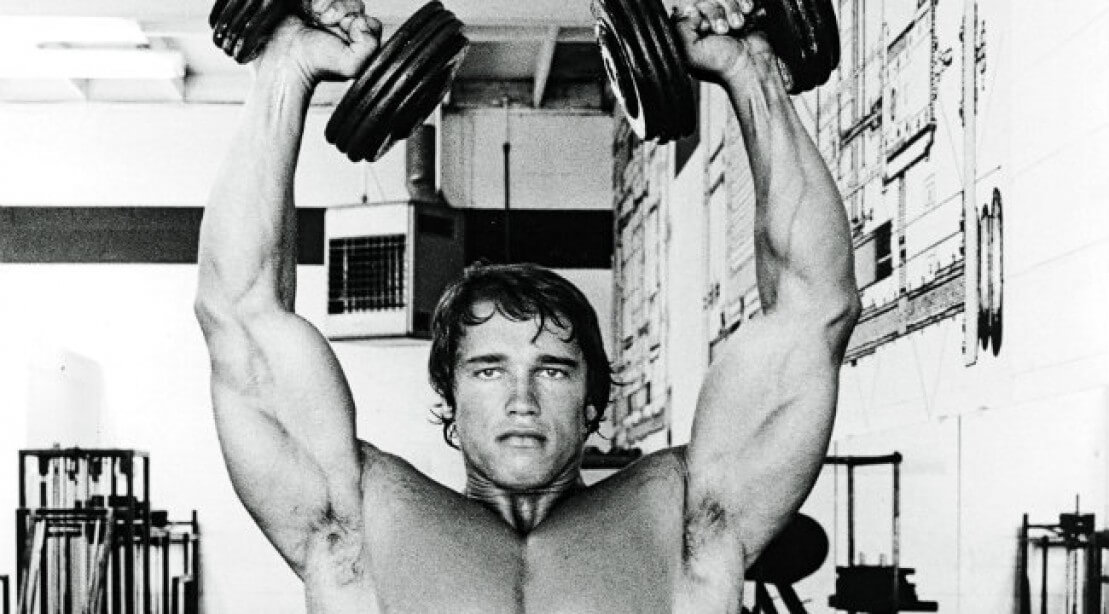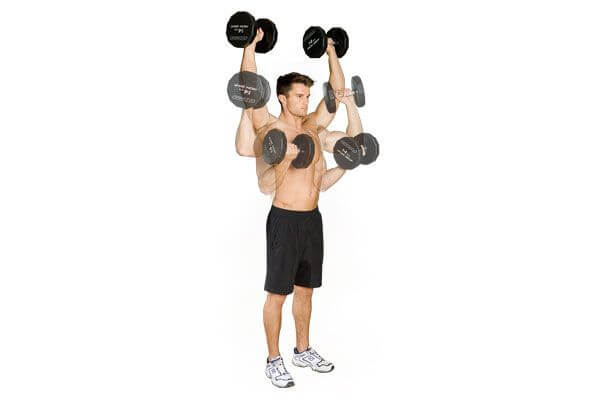Arnold Press – How To Use Arnold Press In Your Workouts
Whether looking to pack on the muscle or blast away fat, you head to the gym to improve your physical health. If you’re aiming for muscular shoulders and powerful arms, one of the best moves you can perform is the Arnold Press.
But what exactly is the Arnold Press, how do you perform it correctly and is it really all that great for your shoulders?
We have all the answers you might need right here.
The Creation of the Arnold Press
If the name isn’t familiar, chances are you’ve at least seen the Arnold Press performed at the gym before.
It became the patterned exercise created by one of the most important bodybuilders in the history of the sport, Arnold Schwarzenegger. The body builder turned action movie star turned governor created the move in order to not only focus on the shoulders but bring the forearms into the move as well.
As an icon for not only action movie fans but weight lifting fans, the Arnold Press has become a rather popular dumbbell move and potentially an excellent addition to your weight lifting routine. He has tons of good routines like the arnold arm workout, among many others.
Variation of the Overhead Press
The overhead press, also known as the shoulder press or military press, is one of the most common presses performed at the gym.
From machine assisted to free weights, overhead press is a staple when it comes to your shoulder workout routine. Understanding how the shoulder press works will help educate on the performance and potential of the Arnold Press.
The overhead press begins by holding a dumbbell over your shoulder.
You can be in a seated or standing position for this. You Push the dumbbells directly up, over your head.
As the weight moves past the head, you lead forward slightly to maintain balance as the additional weight is now directly inline with your spine. Hold the press up in the air with a slight bend in your elbows.
Locking your elbows increases the chance of injury and it also takes the tension away from your shoulders and biceps. Maintaining a slight bend in the joint while holding the weight elevated increases the strain and, in return, possible size gains. One rep of the move is complete after lowering the dumbbells back down to above the shoulders.
The Arnold Press
So what exactly makes the Arnold Press so much different?
It is, in reality, a form of the shoulder press, but the movement is different. To begin, hold a dumbbell in each hand (again, you can perform this move either sitting or standing).
Instead of beginning with the dumbbells above your shoulder, you want each hand in front of your chest, palm facing towards you, as if your holding a pull-up bar at the top of the movement. Keep your elbows and arms pressed against the side of your chest when you begin.
Begin the movement of the lift by moving your elbows to the sides as you push the weight up. The elbows will push the weight up in a slight twisting motion, so by the time the weights are above your head your palms are facing away from you.
Hold the weight in the elevated position for a moment (make sure to not lock your shoulders or any other joints during the lift), then return back down in the reverse movement, coming to a stop with the weights in front of your chest.
The Benefits of the Arnold Press
If Arnold created a press that helped him with his muscle gains, that should probably be enough for anyone, right?
In the world of weight lifting though, it is always good to know the benefits of each move. The Arnold Press in several ways is far superior to the standard overhead shoulder press due to how it targets the muscles and additional muscles it hits.
However, due to the movement and forearm engagement you likely will not be able to use as much weight as you might with a shoulder press, so you don’t need to replace one with the other. Just remember, your body doesn’t know how much weight you’re lifting.
So if it struggles with less weight on the Arnold Press than the overhead press that’s still good, as struggle leads to growth and muscle gains. It’s better to lift lighter weights and challenge your body than heavier weights without the challenge.
While performing the Arnold Press, your body is always engaged.
While holding the dumbbells in front of your chest your forearms are engaged, causing this area of the body to work. The twisting motion of the press also works the shoulder in varying ways from the overhead press. If you’re interested in upper body moves that hit multiple areas of the arms and shoulders, this is an excellent addition to your routine.
Muscles Hit During The Arnold Press
Isolating your shoulders can lead to big muscle growth, same reason why they specifically have rear delt exercises.
While many lifts do touch on some shoulder work, most target other muscle groups as the primary focus.
The Arnold Press directly goes after the shoulder, which makes it an excellent move to perform if you want to strengthen your shoulders and increase size.
The specific target muscle is the anterior deltoid. The deltoid (your shoulder) is broken down into three individual sections. The posterior is the rear of the shoulder, the lateral is the side of your shoulder and the anterior is the front of your shoulder.
For extensive muscle gains and size growth, you need to hit all three sides. If you only perform moves such as the Arnold Press, you run the risk of overdeveloping the anterior portion of the shoulder while the lateral and posterior portions go undersized and under trained.
The anterior deltoid is not the only muscle to receive attention during the move.
While the target muscle, secondary muscles do receive a good amount of attention, which is another reason the Arnold Press is such a valuable addition.
The lateral portion of the deltoid is hit. This occurs due to the twisting motion of the press. While the overhead press almost exclusively hits the anterior deltoid, this move hits the lateral region as well.
The Arnold Press also hits the supraspinatus, better known as the rotator cuff muscle. Your triceps is hit during the lift and twist, as is the serratus anterior, which is the muscle group above your oblique muscles, under your shoulder.
A portion of your back is hit as well, including the trapezius middle and lower (where your shoulders and neck come together).
Two stabilizer muscles are engaged during the move. The trapezius upper, also known as the upper neck, is touched on, although not as extensively as the other portions of the trapezius. The levator scapula, wish is the side portion of the neck, is another stabilizer muscle in use (ExRx, 2017).
Equipment Needs
The only real way to perform the Arnold Press is with dumbbells in each hand.
The traditional overhead press can be done with dumbbells, a barbell or with a machine. However, due to the twisting movement of the Arnold Press, barbells is realistically the only option. Plus, for a move named after Arnold himself, it would be a crime to turn to an exercise machine.
One of the main benefits of not using machines is your stabilizer muscles are hit. You receive additional gain from using free weights over machines, so if ever possible, always go with the free weight over a machine.
If you are in a pinch, trying to work out on the road or just don’t have the equipment around, you can go with resistance bands. Resistance bands are effective tools when on the go or when you have a tight budget.
While dumbbells are still preferred, when nothing else is around, the resistance bands can work.
To Sit or to Stand During The Arnold Press
There are two basic ways to perform the Arnold Press.
You can do it while you sit or you can do it while you stand. Realistically the choice comes down to your personal preference, but each has some benefits and drawbacks. When standing you are open a bit more to cheating on the lift. You can use some momentum created by your lower body to help push the weights up.
You may also open yourself up to some swaying. When sitting, you are not able to generate as much of the cheating momentum, although you may put additional pressure on your lower back as this now becomes the point of contact with the stabilizing surface (the bench).
If you have lower back problems you should go with the standing method.
Ultimately though the decision to sit or stand comes down to your personal preference and what you feel most comfortable with.
The Arnold Shoulder Press Routine
When doing the Arnold Press, who better to take routine tips from than the namesake himself, Arnold Schwarzenegger.
He has provided not only his own Arnold Press routine but his entire shoulder routine, should you want to follow the icon in developing your own shoulders.
First, the Arnold Press. You want to perform four to five sets of eight to 10 reps each. If you’re able to perform more than 10 reps a set the weight you’re using is too light. Arnold also recommends not locking out at the top of the rep.
When you lock out you put more emphasis on your triceps.
However, if you hold just shy of a lockout you’ll engage more of your shoulders, which is the entire purpose of the lift (there are plenty of other lifts that focus specifically on the biceps and triceps).
Now, if you want to follow through with the entire Arnold shoulder routine, you’ll next want to move into the standing side lateral and perform four to five sets of eight to 12 reps of the move.
Follow that up with a seated rear lateral, which again you’ll want to perform four or five sets of eight to 12 reps.
The last move you’ll want to do is the cable side lateral. Perform three to four sets of this at 10 to 12 reps (Muscle and Fitness, 2017).
Who Shouldn’t Perform the Arnold Press and Warnings
The Arnold Press is an excellent way to strengthen your shoulders and boost muscle growth. It is one of the few shoulder moves that hits all three of the shoulder muscle groups (while targeting the front).
Realistically, anyone who is looking to increase their shoulder strength and size should look towards this lift. However, there are certain individuals who should avoid the lift.
For starters, anyone who is recovering from shoulder surgery or rotator cuff surgery should avoid heavy lifting and listen to doctor recommendations for returning to lifting.
If you perform the lift and you feel any kind of pain, it is important to stop the lift and see your doctor. As long as you can perform the lift pain-free though, you should perform this move in your next shoulder routine.
When performing the lift, especially for the first time, you need to go with lighter weights. When lifting free weights overhead, you run the risk of the weights pulling backward while up, fully engaged. This can pull and tear muscle tissue, resulting in serious injuries. If you have been performing the traditional overhead press with free weights you should be more accustomed to the move.
However, if you are used to a machine your stabilizer muscles have not been hit, which is what often leads to these kinds of injuries.
Always play it safe and go lighter when starting a new move.



Comments
Post a Comment